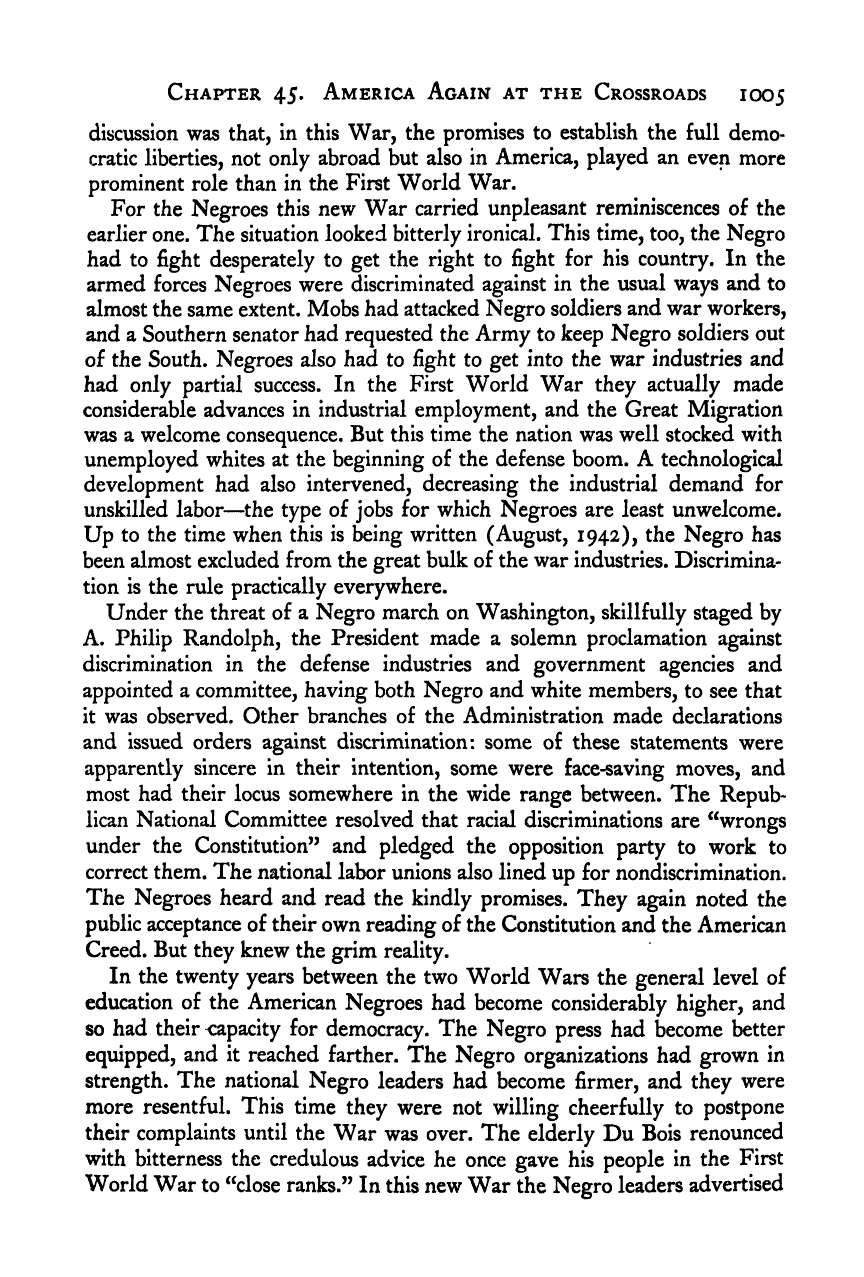Note: Gunnar Myrdal died in 1987, less than 70 years ago. Therefore, this work is protected by copyright, restricting your legal rights to reproduce it. However, you are welcome to view it on screen, as you do now. Read more about copyright.
Full resolution (TIFF) - On this page / på denna sida - XI. An American Dilemma - 45. America Again at the Crossroads in the Negro Problem - 4. Negroes in the War Crisis

<< prev. page << föreg. sida << >> nästa sida >> next page >>
Below is the raw OCR text
from the above scanned image.
Do you see an error? Proofread the page now!
Här nedan syns maskintolkade texten från faksimilbilden ovan.
Ser du något fel? Korrekturläs sidan nu!
This page has never been proofread. / Denna sida har aldrig korrekturlästs.
Chapter 45. America Again at the Crossroads 1005
discussion was that, in this War, the promises to establish the full demo-
cratic liberties, not only abroad but also in America, played an even more
prominent role than in the First World War.
For the Negroes this new War carried unpleasant reminiscences of the
earlier one. The situation looked bitterly ironical. This time, too, the Negro
had to fight desperately to get the right to fight for his country. In the
armed forces Negroes were discriminated against in the usual ways and to
almost the same extent. Mobs had attacked Negro soldiers and war workers,
and a Southern senator had requested the Army to keep Negro soldiers out
of the South. Negroes also had to fight to get into the war industries and
had only partial success. In the First World War they actually made
considerable advances in industrial employment, and the Great Migration
was a welcome consequence. But this time the nation was well stocked with
unemployed whites at the beginning of the defense boom. A technological
development had also intervened, decreasing the industrial demand for
unskilled labor—the type of jobs for which Negroes are least unwelcome.
Up to the time when this is being written (August, 1942), the Negro has
been almost excluded from the great bulk of the war industries. Discrimina-
tion is the rule practically everywhere.
Under the threat of a Negro march on Washington, skillfully staged by
A. Philip Randolph, the President made a solemn proclamation against
discrimination in the defense industries and government agencies and
appointed a committee, having both Negro and white members, to see that
it was observed. Other branches of the Administration made declarations
and issued orders against discrimination: some of these statements were
apparently sincere in their intention, some were face-saving moves, and
most had their locus somewhere in the wide range between. The Repub-
lican National Committee resolved that racial discriminations are ‘Wrongs
under the Constitution” and pledged the opposition party to work to
correct them. The national labor unions also lined up for nondiscrimination.
The Negroes heard and read the kindly promises. They again noted the
public acceptance of their own reading of the Constitution and the American
Creed. But they knew the grim reality.
In the twenty years between the two World Wars the general level of
education of the American Negroes had become considerably higher, and
so had their capacity for democracy. The Negro press had become better
equipped, and it reached farther. The Negro organizations had grown in
strength. The national Negro leaders had become firmer, and they were
more resentful. This time they were not willing cheerfully to postpone
their complaints until the War was over. The elderly Du Bois renounced
with bitterness the credulous advice he once gave his people in the First
World War to “close ranks.” In this new War the Negro leaders advertised
<< prev. page << föreg. sida << >> nästa sida >> next page >>